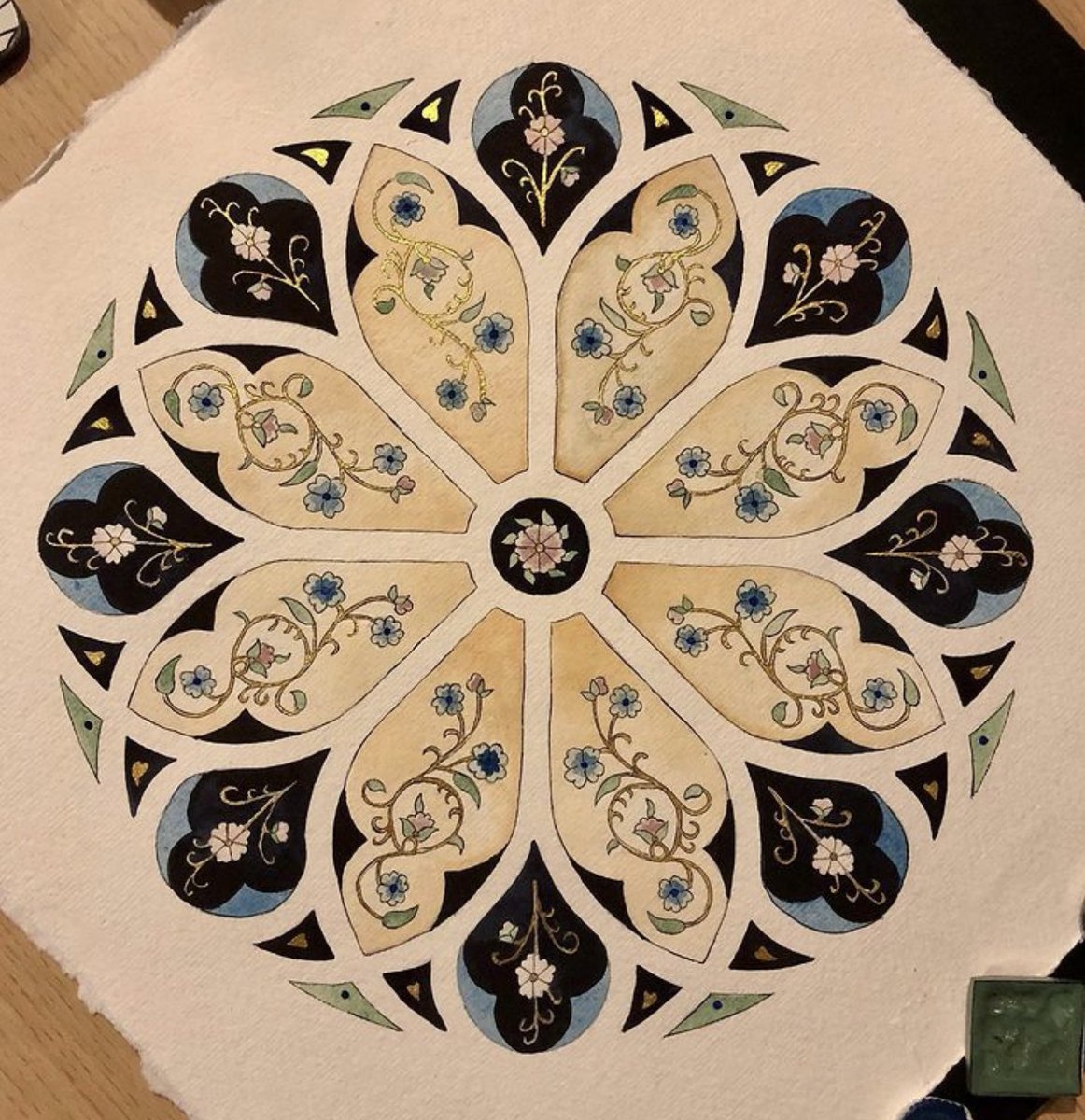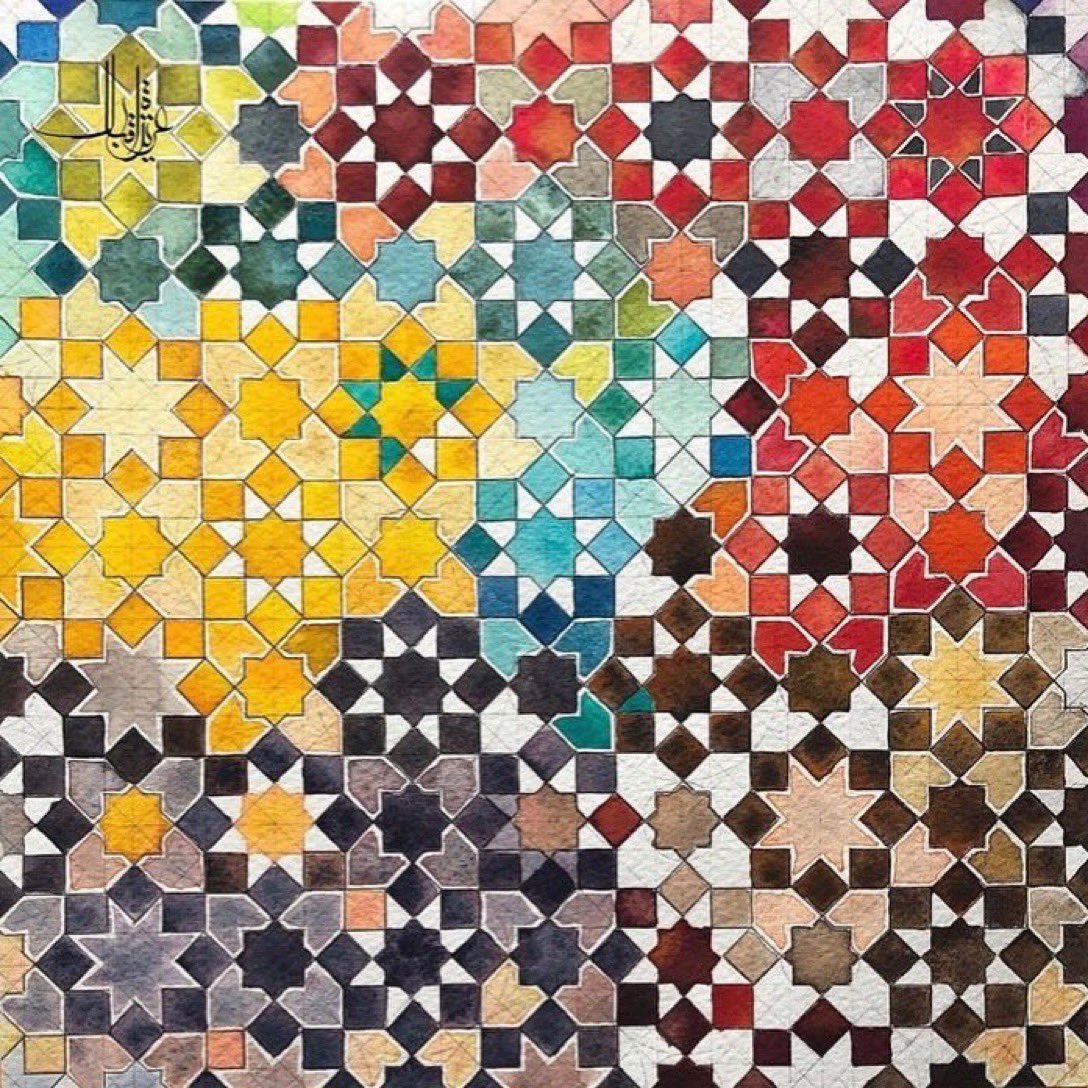Geometric patterns are one of the most distinguishing features of Islamic art, thought to reflect the language of the universe & the greatness of creation
Today, artists are reinterpreting this traditional artform in new ways
A thread on 24 artists redefining Islamic geometry…
Today, artists are reinterpreting this traditional artform in new ways
A thread on 24 artists redefining Islamic geometry…

1/ After completing a bachelor’s in accounting & finance, Indian artist Antara Biswas took the plunge, switched careers and pursued what she loved doing most, creating art inspired by Islamic geometry…
baytalfann.com/post/self-disc…
baytalfann.com/post/self-disc…

2/ Artist @SKbydesign work tells stories which are about celebrating something long forgotten, and a reclamation narratives. She is interested in colonial legacies, social justice & using art as a tool for change… 

3/ UK based artist & educator @samira_mian has a passion for Islamic art & culture.
An experienced teacher of mathematics with Islamic geometry, she has created a contemporary take on tradition, promoting her art both in the UK & internationally…
baytalfann.com/post/educating…
An experienced teacher of mathematics with Islamic geometry, she has created a contemporary take on tradition, promoting her art both in the UK & internationally…
baytalfann.com/post/educating…

4/ Shaimaa Osman is a Dutch-born, North African Sudanese junior doctor & artist based in Devon.
She is renowned for her creative approach to Islamic art, through an exploration of geometry, calligraphy, maps & collage…
baytalfann.com/post/maps-glob…
She is renowned for her creative approach to Islamic art, through an exploration of geometry, calligraphy, maps & collage…
baytalfann.com/post/maps-glob…

5/ Alifia Khan is a self taught artist, with a passion for Islamic geometry. She found her interest in Islamic art during the COVID-19 pandemic…
baytalfann.com/post/sacred-ge…
baytalfann.com/post/sacred-ge…

6/ For artist Ameet Hindocha, developing a multi-disciplinary practice with geometry at its core has allowed him to tap into an ancient but living tradition of design, and explore it with the tools & technology today…
baytalfann.com/post/infinite-…
baytalfann.com/post/infinite-…

7/ Influenced by her Persian roots and Iranian heritage, artist Ghazaleh Khayat specializes in Islamic geometry and pattern. Architecture & monuments are a key source of inspiration behind her detailed works…
baytalfann.com/post/persian-p…
baytalfann.com/post/persian-p…

8/ Artist @elisadeaneart impeccable use of colours and detailed brushwork are inspired by Islamic geometry & the miniature painting traditions of India & Iran…
baytalfann.com/post/contempor…
baytalfann.com/post/contempor…

9/ Clarissa Grandi is a UK-based geometric artist & teacher of mathematics.
@c0mplexnumber is influenced by Islamic pattern & explores the interplay between rigid, regular, human-made geometry and nature’s organic, chaotic geometries & symmetries…
baytalfann.com/post/nature-ge…
@c0mplexnumber is influenced by Islamic pattern & explores the interplay between rigid, regular, human-made geometry and nature’s organic, chaotic geometries & symmetries…
baytalfann.com/post/nature-ge…

10/ Ingrid Parrington is an American physician who has been turning Islamic geometric patterns into stained glass since 2018. A pivotal trip to the UAE exposed her to the beauty of Islamic art, and she has been a devout student of geometry ever since…
baytalfann.com/post/glass-ing…
baytalfann.com/post/glass-ing…

11/ Whilst studying mathematics at university, artist @em_3190 found inspiration in Islamic geometry. After learning more about Islamic illumination, she developed a unique style bringing a contemporary twist to this traditional art-form…
baytalfann.com/post/talking-i…
baytalfann.com/post/talking-i…

12/ For visual artist Margi Lake, the beauty, mystery & genius of Islamic geometric patterns is timeless & universal. They express the principles & realities that govern the cosmos, the natural world & human nature…
baytalfann.com/post/the-cosmo…
baytalfann.com/post/the-cosmo…

13/ Known for her ingenious use of colour & mastery of Islamic geometry, biomorphic patterns & illumination, @EsraAlhamalArt is an artist & researcher based in London
Her work experiments & reinterprets traditional practices in contemporary ways…
baytalfann.com/post/illuminat…
Her work experiments & reinterprets traditional practices in contemporary ways…
baytalfann.com/post/illuminat…

14/ Rajen Astho completed his MA degree in music composition in St. Petersburg, Russia in 2010. Around the same time he discovered his second big passion, the art of Islamic geometric pattern, which blossomed over the next few years…
baytalfann.com/post/decipheri…
baytalfann.com/post/decipheri…

15/ Sandy Kurt's passion for Islamic geometry began in 2016 with an online course, an old compass and some cheap watercolours.
Her complex geometry and sense of colour has inspired `` thousands of artists to get started…
baytalfann.com/post/creating-…
Her complex geometry and sense of colour has inspired `` thousands of artists to get started…
baytalfann.com/post/creating-…

16/ Canadian artist @oalanqar is inspired by Islamic geometry & indigenous art.
She believes it is important for people to connect with their roots, & makes connections to culture & heritage through her art…
baytalfann.com/post/forgotten…
She believes it is important for people to connect with their roots, & makes connections to culture & heritage through her art…
baytalfann.com/post/forgotten…

17/ Artist @halimacassell is one of the UK’s most distinctive, & dynamic ceramicists & sculptors.
Her work is instantly recognizable due to her bold designs, crisp carving & intuitive understanding inspired by geometry, architecture & nature…
baytalfann.com/post/carved-ge…
Her work is instantly recognizable due to her bold designs, crisp carving & intuitive understanding inspired by geometry, architecture & nature…
baytalfann.com/post/carved-ge…

18/ Aziza Iqbal is an Indian Islamic visual artist based in Doha, Qatar
A passion for sacred geometry, Aziza uses both traditional & digital media to create vibrant, contemporary geometric compositions, drawn & painted using classical tools & techniques…
baytalfann.com/post/sacred-he…
A passion for sacred geometry, Aziza uses both traditional & digital media to create vibrant, contemporary geometric compositions, drawn & painted using classical tools & techniques…
baytalfann.com/post/sacred-he…

19/ Bryn Edmonston is a self-taught artist specializing in colorful geometric layered paper cutouts, putting a contemporary twist on an ancestral art form. Her work is inspired by the tiling and plaster carvings of Southern Spain…
baytalfann.com/post/paper-geo…
baytalfann.com/post/paper-geo…

20/ Ceramic artist Paul Barchilon creates intricate designs that take us on a voyage of discovery within the circle.
He found his niche in Moroccan art & from within a 1300 year old tradition of Islamic geometric design…
baytalfann.com/post/ceramics-…
He found his niche in Moroccan art & from within a 1300 year old tradition of Islamic geometric design…
baytalfann.com/post/ceramics-…

21/ For British Muslim Artist @shaheenkahmed empathy is central to her practice. Islamic geometry is core to her work, & she explores social justice using maps as a tool for conversation…
baytalfann.com/post/mapping-e…
baytalfann.com/post/mapping-e…

22/ British Muslim artist & brandalism activist @Teakster is shaping our understanding of contemporary Islamic art today.
He connects communities by challenging perceptions of space, replacing outdoor advertising with beautiful artwork…
baytalfann.com/post/brandalis…
He connects communities by challenging perceptions of space, replacing outdoor advertising with beautiful artwork…
baytalfann.com/post/brandalis…

23/ Working at the intersection of art and science, @matthewshlian describes himself as a “paper engineer.” His use of both geometry and paper has defined his craft, with drawings, prints & sculpture that are unique in their manifestation…
baytalfann.com/post/mattshlian
baytalfann.com/post/mattshlian

24/ British artist @zarahkhussain combines contemporary digital art with a training in hand drawn Islamic geometry. Her work encompasses animations made with code, interactive apps, painting, paper & sculpture…
baytalfann.com/post/unexpecte…
baytalfann.com/post/unexpecte…

• • •
Missing some Tweet in this thread? You can try to
force a refresh






















